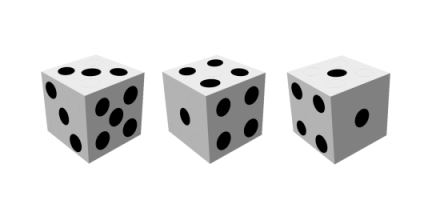Lake Wobegon Dice
Garrison Keillor's fictional Lake Wobegon is a place where all the children are above average." Donald Knuth alluded to this in his exercise regarding Lake Wobegon Dice," a set of dice where the roll of each die is (probably) above average.
Let A be a six-sided die with a 5 on one side and 3's on the other sides.
Let B and C be six-sided dice with 1's on two sides and 4's on four sides.

Then the probabilities
Pr( A > (A + B + C)/3 )
Pr( B > (A + B + C)/3 )
Pr( C > (A + B + C)/3 )
are all greater than 1/2.
To see this, list out all the possible rolls where each die is above average. The triples show the value of A, B, and C in that order. We have A above average if the rolls are
(3, 1, 1)
(3, 1, 4)
(3, 4, 1)
(5, *, *)
These outcomes have probability 5/54, 10/54, 10/54, and 1/6. The total is 34/54 = 17/27 > 1/2.
We have B above average when the rolls are
(3, 4, *)
(5, 4, 1)
which have probability 5/9 and 1/27 for a total of 16/27 > 1/2. And C is the same as B.
It seems paradoxical for three different dice to each have a probability better than 1/2 of being above average. The resolution is that the three events
A > (A + B + C)/3
B > (A + B + C)/3
C > (A + B + C)/3
are not exclusive. For example, in the roll (3, 4, 1) both A and B are above the average of 8/3.
I ran across this in The Art of Computer Programming, Volume 4, Pre-fascicle 5A, Exercise 3. Fascicle 5 has since been published, but I don't have a copy. I don't know whether this exercise made it into the published version. If it did, the page number may have changed.
More dice posts- Illustrating Euler characteristic with dice
- More sides or more dice?
- Generating Gaussian samples from dice